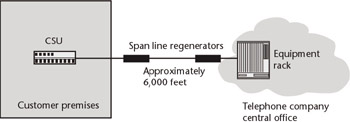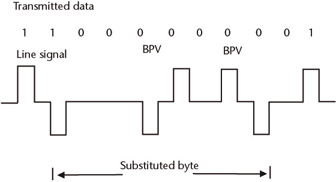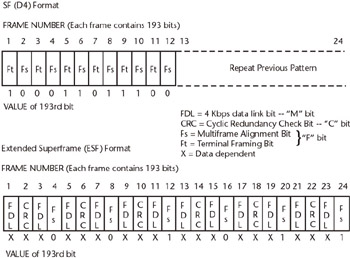9.3 CSU Functionality
|
| < Day Day Up > |
|
For T1 systems, the CSU interfaces the carrier’s digital facilities with the user’s DTE. Because most terminal equipment that uses high-capacity 1.544 Mbps service (e.g., channel banks, multiplexers, PBXs) provides a four-wire DS1 interface, only the CSU function is required (see Figure 9.4). All T1 CSUs provide a regenerator to reconstitute signals that have been attenuated and distorted by the T1 span line or the customer’s in-house cabling. This function is also part of the FCC Part 68 equipment registration requirements for CSUs.

Figure 9.4: Deployment of CSUs and regenerators along a T1 span.
Line build out (LBO) is a functional requirement of all Part 68 registered T1 CSUs. LBO is an electronic simulation of a length of wire line that reduces the signal power so that it falls within certain limits (±7.5 dB). This is done to reduce the potential for one T1 transmitter to “cross-talk” into the receiver of other services within the same cable binder and to accommodate the first span line repeater’s receiver. The carrier establishes the proper LBO setting and simply instructs the user as to which one of three CSU settings to choose. A test signal is looped back over the receive pair and measured for signal loss. Through this procedure, the telephone company determines the line loss so that the proper setting can be made on the CSU.
DS1 circuits are designed to incorporate regenerators at approximately 6,000-feet intervals. As a practical matter, many telephone company installations position the final span repeater at less than half that distance, or 3,000 feet, from the network interface. This facilitates loop-back testing at the interface. By simply installing an RJ-48X jack (with transmit [Tx] and receive [Rx] shorting bars), removal of the CSU causes the Rx pair to be looped back mechanically to the Tx pair. The other benefit of this method of installation is that the customer can use the remaining 3,000 feet. This provides more flexibility to deal with problems related to inconsistent carrier installations and the placement of demarcation points, especially in multistory buildings. This flexibility means that users do not have to access riser cabling to insert regenerators and find appropriate CSUs to deliver the necessary power to the regenerators.
In addition to regenerating the received line signal and pre-equalizing the transmitted signal through the LBO, the CSU ensures that the user’s DTE does not send signals that could disrupt the carrier’s network. For example, very long strings of zeros do not provide timing pulses for the span line regenerators to maintain synchronization. The CSU monitors the data stream from the attached DTE so that the “ones-density rule” (e.g., the customer’s data shall have at least a 12.5% pulse density), which governs transmission over high-capacity 1.544 Mbps services, is not violated. The CSU will inject pulses if excessive zeros are being transmitted by the attached DTE. Transmissions with more than 15 consecutive zeros or ones-density averaging more than 12.5% could degrade network performance.
The CSU also removes bipolar violations of the AMI rules from the incoming signal, and it provides isolation between the DTE and the network to protect equipment and telephone company technicians from the potentially harmful line voltages and lightning surges that may propagate beyond the DTE. The CSU must also be able to send a “keep-alive” signal toward the network upon loss of a signal from the DTE to provide the T1 span line regenerators with timing pulses.
For DDS, there are two control signals that can be passed from the subscriber’s DSU to the network. “Control mode idle” is transmitted when the terminal’s RTS signal is turned off. “Excessive zeros” is transmitted when the terminal is sending six or seven consecutive spaces for subrate or 56-Kbps service, respectively. Both types of control signals are passed by using bipolar violations: two successive pulses of the same polarity that violate the AMI encoding rule.
Because the CSU interfaces user equipment with carrier facilities, it provides a window on the network, allowing both the carrier and the customer to perform testing up to the same point. CSU access to the network has prompted vendors to equip it with increasingly sophisticated diagnostic and network management features that greatly enhance user control and ensure the integrity of the T1 circuit.
9.3.1 Clear Channel Capability
Clear channel capability permits users to transmit DS1 signals with no restriction on the number of consecutive zeros. This is achieved by a line-coding technique called B8ZS, which is described in AT&T Technical Reference 62411. Although zero byte time-slot interchange (ZBTSI) also implements clear channel signaling, this method is not addressed in this discussion because B8ZS emerged a long time ago as the coding of choice among service providers and equipment vendors. B8ZS also supports the transmission of encrypted data over T1 circuits, without regard to the zeros content of the data. To take advantage of clear channel signaling, the user must have CSUs that conform to the B8ZS standard (see Figure 9.5).

Figure 9.5: B8ZS is a line-coding scheme that substitutes a known pattern for eight consecutive zeros. B8ZS maintains the ones-density rule at relatively little bandwidth overhead.
As an alternative to the classical AMI method of T1 encoding, B8ZS uses pulses that violate the AMI encoding rules (e.g., bipolar violations) to replace strings of eight consecutive zeros with a special pattern. This B8ZS pattern assures timing pulses, regardless of the data, so that synchronization problems do not occur. B8ZS does not inject errors because it guarantees that the minimum pulse density requirements are met without actually stuffing pulses into the production data stream.
Because B8ZS gets around the 15 consecutive zeros restriction, it provides for a clear signaling channel and is therefore said to be providing a “clear channel” capability. So B8ZS use applies all of the T1 bandwidth to data transmission and, in turn, the full 64-Kbps DS0 bandwidth, effectively removing the 56-Kbps limit associated with DDS. B8ZS transmitter circuitry in the CSU monitors the data stream from the terminal equipment for excessively long strings of zeros. When detected, these strings of zeros are replaced with a bipolar violation before being transmitted to the network. A compatible CSU at the other end recognizes this violation and converts it back into its original string of zeros.
9.3.2 Diagnostics
Realizing that users would be deploying CSUs and DSUs for digital transmission in a manner similar to that for modems over analog facilities, vendors over the years have added maintenance and fault-isolation capabilities to differentiate their offerings from those of competitors. Because these devices are strategically positioned at the network interface, they can be used to implement various tests to ensure the proper operation of the unit and the line.
With so many vendors involved in providing end-to-end connectivity, each with its own brand of equipment and type of cabling, troubleshooting the link has become a complex and arduous task. CSUs and DSUs are a natural and convenient point for such troubleshooting activities. With their built-in capabilities for self-diagnostics, as well as DTE loopback and network loopback tests, problems can be isolated along any point of the network. Tests may be initiated either locally from the front panel or remotely through a network management system.
Because the CSUs and DSUs are physically separate from the DTE, their maintenance features may be used even when the DTE becomes inoperable. This minimizes the requirement for expensive, external test equipment. For more extensive testing, however, some T1 CSUs do provide jack access for external test equipment.
The most essential diagnostic capabilities found in CSU-DSUs are loopbacks, which enable technicians to test communications through portions of the network and isolate problems. They can be initiated by the carrier or the customer locally or through the network remotely. These loopback tests are frequently used to isolate problems and are disruptive only to the receive path of the element being tested. For example, individual frame relay permanent virtual circuits (PVCs) may be looped back without affecting other PVCs. Many T1 CSU-DSUs also present DSX-1 ports to the customer and may let individual DSUs be looped back while other channels remain undisturbed. The following are examples of loopbacks:
-
DTE loopback: Reflects data sent via DTE port back to DTE. The signal, framing, and CRCs are regenerated during a payload loopback, whereas line loopbacks regenerate the signal only.
-
Network loopback: Reflects data sent viaWANport back to WAN, using payload or line loopback options as with DTE tests. Network loopbacks may be initiated inband by the carrier or remote site, or locally from the network management system (NMS) or front panel.
-
Frame relay PVC loopback: In a frame relay environment, data on an individual PVC may be sent back to its source.
CSUs and DSUs offer diagnostics via loopback tests to check the subscriber loop between the customer’s equipment and the carrier’s facilities, as well as the entire circuit between near-end and far-end CSU-DSUs. Many CSUs and DSUs allow the user to perform DTE loopback tests to verify the integrity of the link between the CSUs and DSUs and the originating terminal equipment. CSU-DSUs are equipped with various types of monitors to facilitate problem determination. Units equipped with front-panel LEDs can readily display information about bipolar violations received from the network, loss of DTE signal, loss of network and equipment synchronization, and detection of certain alarm conditions.
Because CSU-DSUs must rigidly adhere to network specifications and FCC regulations, one vendor’s product would seem to need to be compatible with those of another vendor and capable of being mixed on the same network. This is true up to a point. While these devices will transfer data back and forth, most vendors have added proprietary testing techniques that will not interoperate with the products of other vendors.
9.3.3 Circuit Maintenance
Some T1 CSUs support both the D4 superframe (SF) and ESF formats. ESF is useful in helping the service providers maintain the network. ESF extends the normal 12-frame SF structure of the T1 to 24 frames (hence the name “extended superframe”). By doubling the number of framing bits available for diagnostics, more functionality is available (see Figure 9.6). Of the 8-Kbps bandwidth (repetition rate of the 193rd bit or framing bit), 2 Kbps are used for framing, 2 Kbps for CRC, and 4 Kbps for a facilities data link (FDL) for two-way communication along a T1 circuit.

Figure 9.6: A comparison of how the 193rd bit is used in SF (D4) and ESF formats.
With CRC, the entire circuit may be segmented so that it can be monitored for errors without disrupting normal data traffic. In this manner, performance statistics can be maintained to determine the quality of the T1 circuit. ESF diagnostic information, often displayed on a terminal or computer, is most useful to support troubleshooting by the carrier. For user T1 circuits with ESF, the supervisory terminal provides information about T1 link performance over protracted periods of time, furnishing a historical record of circuit performance.
The original ESF, as described in AT&T Technical Reference 54016, required that the CSU compile performance statistics (from the CRC) every 15 minutes. This information would be kept updated for a full 24 hours, so that a complete one-day history could be accessed by the service provider. Under the AT&T ESF method, the carrier could poll each CSU to retrieve data and clear these storage registers on a demand basis. By equipping the ESF CSU with dual registers (one for the carrier and one for the user), both carrier and user alike have full access to the performance history.
A newer version of ESF, standardized as ANSI T1.403, does not require the CSU to store performance data for 24 hours. Also, the CSU no longer will respond to polled requests from carriers but will simply transmit (volunteer) ESF performance messages every second. The new standard requires that approximately 200 bps be transmitted to the CO without polling. The CSUs will be required to gather statistics on clock synchronization errors and framing errors, as well as errored seconds, severely errored seconds, failed seconds, and bipolar violations that are currently reported by CSUs.
Customers can use ESF to gather end-to-end performance data and sectionalized alarms in real time. This enables them to narrow down problems between carrier-access points and on interoffice channels and to find out in which direction the error is occurring.
As the networks become more complex from the addition of multiple local and interexchange service providers, all carriers will need access to ESF performance data. Most likely, no one carrier will have complete control. If, for example, one interexchange carrier did have the ability to clear the remote CSU registers, local exchange carrier access to the accumulated information would be precluded.
Recognition of this potentially disruptive situation led to the development of the T1.403 monitoring standard for ESF.
9.3.4 Impairment Testing
Depending on the design of the CSU, certain impairments, such as jitter, may actually be reduced, thereby improving overall system performance. Data applications are much more sensitive than voice to jitter because errors forced in the least significant bits (LSB) of the digitized analog signal (e.g., those bits that have the smallest value in a binary word or number) are almost undetectable by the human ear.
Today’s ESF CSUs not only provide conversion between D4 and ESF signals but also monitor signals received from the line, generate alarms based on user-defined thresholds, and report these alarms to a control location. These devices invoke system tests in a variety of ways: from a central location through a network management system; locally via front-panel switches on the units themselves, or from a terminal or microcomputer connected to a supervisory port.
T1 CSU-DSUs are also available to support interface and data rate translations from the standard DS1 format to V.35 terminal interfaces used on high-speed front-end processors requiring 1.536 Mbps serial data transmission. These CSU-DSUs can perform other speed conversions to support FT1 transmission. This speed translation may be required for videoconferencing equipment and for unchannelized high-speed data from LANs to bridge together remote locations.
|
| < Day Day Up > |
|
EAN: 2147483647
Pages: 184